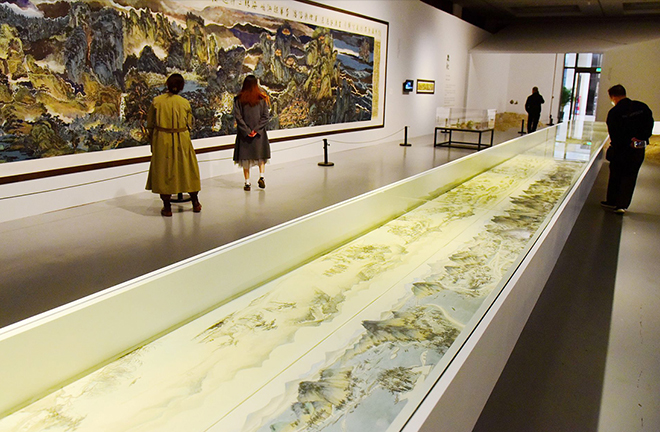Seminar taps into Tang Dynasty literary creations

An art exhibition on the theme of “poetry road of the Tang Dynasty” at Zhejiang Exhibition Hall in Hangzhou, Zhejiang Province, on Mar. 10, 2022 Photo: CFP
The 21st Annual Conference of Chinese Tang Dynasty Literature and the International Seminar on Tang Dynasty Literature were held concurrently via video links on Dec. 11, 2022, with scholars from the Chinese mainland, Hong Kong, and Taiwan, as well the United States and Japan in attendance. The conference focused on the literati, texts, documents, and genres of Tang Dynasty (618–907) literature, furthering the in-depth development of the field.
Deeper research needed
There were more than 3,000 poets in the Tang Dynasty, producing a great volume of works in different styles. However, less than 300 poets have been studied in depth at home and abroad. Poets Bai Juyi, Han Yu, Liu Zongyuan, Li He, and Liu Yuxi remain the most studied mid-period poets, while Du Fu, Li Bai, and Wang Wei are the most studied of the dynasty’s peak period. Scholars of these poets tend to be more inclined towards appreciative, annotative, and descriptive expressions as opposed to in-depth studies. For instance, there is still no consensus among academics as to when the three poems of Li Bai’s “Difficult Roads to Travel” were written.
In the opinion of Zhan Furui, former curator of the National Library of China and a professor with Capital Normal University, the key to clarifying the written dates lies in the interpretation of Li Bai’s allusions in the poems. Sharing similar feelings, tones, and styles, these three poems were likely written during the same period and should not be broken apart. They were all created before and after Li Bai served the imperial court, clearly expressing his experiences and feelings in Chang’an [capital of the Tang court, modern-day Xi’an, Shaanxi Province].
“The Tang poetry road” has been a new academic focus in recent years. Tang Dynasty poets traveled all across China, forming routes of “poetry roads,” which help unravel the development of Tang literature from a new angle. Lu Shengjiang, a professor from the School of Literature at Nankai University, found that the poetry road in eastern Zhejiang Province in the early Tang Dynasty was a transition from that of the Eastern Jin Dynasty (317–420) and the Southern Dynasties (420–589) to the climax of the Tang poetry road. During that period, the famous mountain culture gradually took shape in eastern Zhejiang, recording the footprints of poets together with the celebrated literati culture. The poetry road thus took an early form, and the poetry road culture began to present its characteristics. By early Tang, eastern Zhejiang witnessed the cultivation of more poets and their works. In the peak period and early mid-Tang, this poetry road saw more poets and poems, wandering and reclusive poets, far outnumbering early Tang, indicating that early Tang was merely an initial stage of the eastern Zhejiang poetry road.
Gatherings, partings, and composing reciprocal and wall-scribed poems were activities frequently occurring in the life and creations of the Tang people. However, it was undoubtedly the mid Tang poets Yuan Zhen and Bai Juyi who most prolifically assembled these elements and performed them frequently, deeply, and vividly. Shang Yongliang, a professor from the College of Chinese Language and Literature at Wuhan University, said that most of the abovementioned activities were not common in the normal lives of Yuan and Bai while officials of the court, but occurred during their arduous journeys following their relegation, which has unique significance. Demotion provided the two poets with opportunity of mutual salvation, farewell, and reunions. They composed reciprocal poems across time and space, and wrote wall-scribed poems to leave messages, encouraging each other by writing poems. They transcended the mundane and acquired profound experiences of life in decline, all the while conveying multi-level content and feelings in their writings.
Multi-angle research
Over the years, Tang Dynasty literary research has produced consistency in terms of theoretical constructs and operation. Furthermore, multi-angle and multi-level research directions and diverse research methods have laid a solid foundation for the horizontal expansion of Tang Dynasty literature research.
The meaning of Tang Dynasty gardens and garden-themed literature carries a unique “cultural memory.” Li Hao, a professor from the Faculty of Liberal Arts at Northwest University, borrowed the opinion of German scholar Jan Assmann and proposed that ancient relics, including Tang gardens, play the role of “cultural memory,” carrying the past and directing an eternal future for the people. Through the memory of environmental information and spatial orientations, Tang gardens are transformed into poems, texts, paintings, and scenic spots, creating a unique “spatial-temporal memory.” Through the textualization of scenic spots, the symbolization of landscapes, and the transformation from visiting historical sites to interpreting texts, Tang gardens are translated from historical memory into cultural interpretation. It is by means of this “cultural memory” that the ancients constructed an infinitely broad view of time and space.
Although Meng Haoran has entered the English world together with other poets in the century-long process of the English translation of Tang poems, he has yet to receive attention commensurate with his works. Lan Jiang, an associate professor from St. Peter’s University in the United States, pointed out that at the dawn of the 21st century, literary translators endowed Meng with the image of “a poet with Buddhist perceptions,” triggering greater interest in Meng among scholars and translators. For domestic scholars of Meng, limited by their native linguistic culture, the interpretation methods and perspectives of Western translators offer salutary supplements and references to transcend monocultural frameworks.
Edited by YANG LANLAN
